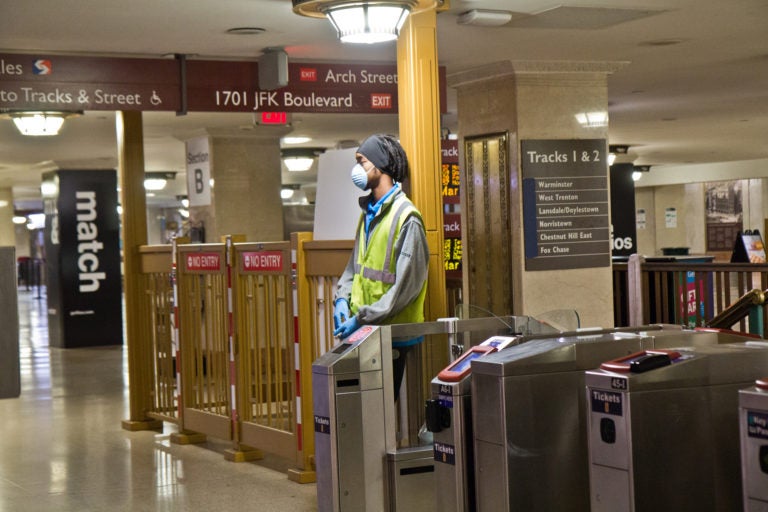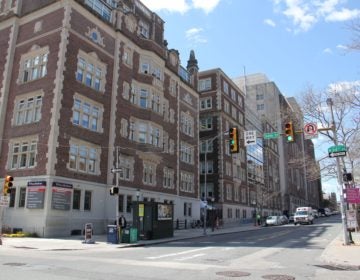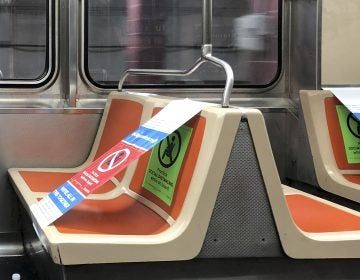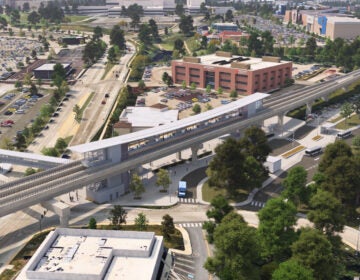SEPTA seeks 10,000 face masks as pandemic continues to take a toll on transit service
SEPTA is racing against the pandemic’s spread, continuing to adapt to heightened risks and a reduced workforce that is calling for more protections.

Regional rail stations were nearly empty on March 17 in the wake of the coronavirus shutdown. (Kimberly Paynter/WHYY)
SEPTA needs 10,000 face masks.
As the coronavirus pandemic triggers a shortage in protective equipment for essential frontline workers, the regional transportation is struggling to respond to increasingly urgent calls from workers for more safeguards.
By April 1, close to two dozen SEPTA employees tested positive for the coronavirus, including some bus drivers, cashiers and other customer-facing employees in subway stations.
The number is bound to increase as the region continues to rely on transit workers to get people to hospitals, grocery stores, and other essential workplaces.
In addition to seeking face masks to purchase, SEPTA has retrofitted buses and trolleys with protective shields to reduce operators’ exposure to riders, enacted a rigorous cleaning schedule and made a bevy of other service changes — some for safety and some because of the pandemic’s impacts on its workforce.
“In consultation with infectious disease specialists, we continually assess and evaluate the steps we need to take to provide appropriate protective equipment to employees while following all CDC guidelines,” said Andrew Busch, a SEPTA spokesperson. “While sourcing protective equipment has been a global challenge, SEPTA collaborates with our transit counterparts to ensure we are following current best practices.
Yet the measures have not stopped the number of infections among the workforce from growing and workers report feeling endangered as they report to necessary jobs in the midst of the crisis.
TWU Local 234 president Willie Brown, earlier this week, in a video posted online, accused SEPTA of putting “profit over people” by not putting in place proper safety precautions and not paying workers hazard pay. “I don’t believe SEPTA is taking this seriously enough,” Brown said.
Brown and general manager Leslie Richards have since talked over their differences in person, leading to results that both union leaders and SEPTA officials have described in positive terms.
“We’re hopeful and confident things will go much better and much safer going forward,” said Joe Coccio, secretary-treasurer for the union.
Racing a pandemic
But like every other public and private enterprise, SEPTA is racing against the pandemic’s spread, continuing to adapt to heightened risks and a reduced workforce.
“We have to be prepared … to operate with fewer employees,” said Busch. “Obviously people are getting sick and they’re going to be out. So we’re going to have to look ahead and prepare for that.”
Riders must now enter buses and trolleys through the rear doors and SEPTA suspended on-board fare payment to promote social distancing. Passengers with disabilities can still enter through the front.
However, some trolley stops have turnstiles, which are still operational. This may raise an issue of fairness for some riders.
“We really would hope that people look at it for what it is,” said Andrew Busch, a SEPTA spokesperson. “It’s a temporary order for an emergency situation. It’s certainly not going to be something that we have implemented permanently.”
Now that trips on buses and trolleys are basically free to riders, SEPTA implemented rider limits to discourage nonessential trips and promote social distancing.
Up to 20 riders are permitted on buses, while trolleys are allowed up to 25. The Norristown High Speed Line will allow up to 30. Operators will keep track of the number of riders on vehicles. Once the limit is reached, the service will switch to drop off only until enough room is freed up.
SEPTA also made changes to the Routes 101 and 102 trolley service for more efficiency. The two lines run along the same route for 10 stops before splitting.
The 101, which runs from 69th Street to Media, now operated as a bus line, and the 102, which runs from 69th Street to Sharon Hill, will be suspended. Officials say bus service can provide an alternative for riders.
Due to the pandemic, SEPTA estimates a loss of more than $150 million for FY2020, with more losses to come. The authority sought to minimize the fiscal damage wrought by the pandemic with cost-cutting measures to their operations such as elimination of overtime, an executive pay cut and service reductions. Transit ridership is down to about 22% of usual numbers, while Regional Rail is at a scant 4%.
Scott Goldstein, policy director for the advocacy group Transportation for America, says it can take years for transportation agencies to return to normal operations, if ever.
“If transit agencies had to cut service, it would be very hard to restore it,” he said. “That’s just the nature of the business.”
He pointed to transportation relief efforts after the 2008 recession, which provided agencies $8.4 billion in relief dedicated to capital assistance. This led to a strain on transportation agencies and longer service cuts, he said.
The current $2.2 trillion relief package provides $25 billion in the form of operational relief. Agencies may need more money in the future, but focusing on operations can help minimize the long-lasting cutbacks, says Goldstein.
Busch says they ought to have a more concrete idea of how much they’re looking for by the end of the week, but it ought to be enough to “stretch over a pretty good amount of time.”
As ridership returns, whenever that may be, some things ought to return to normal. Busch pointed to overtime and lifting the hiring freeze. But they’re going to have to “keep looking at ways to control costs,” even with the federal money.
“It’s probably not all going to happen at once,” said Busch. “We’ll have to see how things get back to normal and what people’s new normal is after this.”
WHYY is your source for fact-based, in-depth journalism and information. As a nonprofit organization, we rely on financial support from readers like you. Please give today.






![CoronavirusPandemic_1024x512[1]](https://whyy.org/wp-content/uploads/2020/03/CoronavirusPandemic_1024x5121-300x150.jpg)



